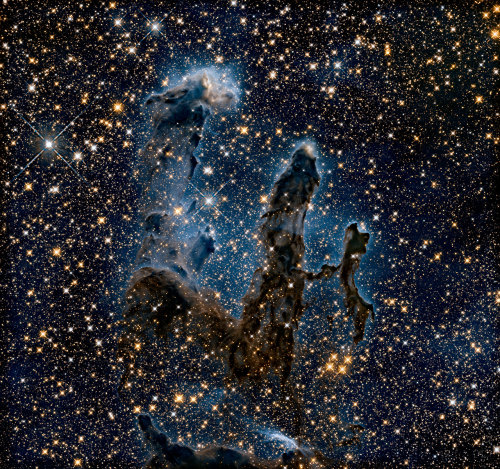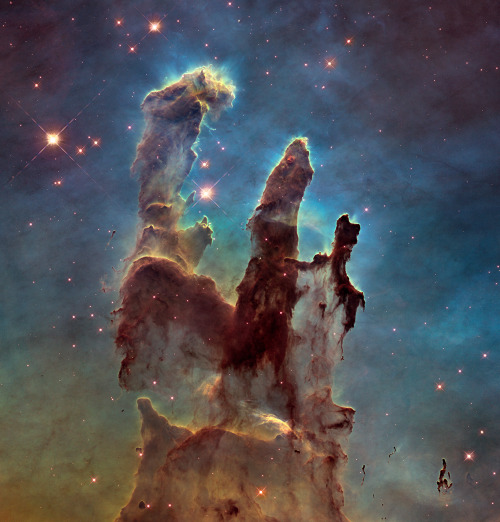Epic-flight - Epic Flight
More Posts from Epic-flight and Others









“I would like to humanize the space age by giving a perspective from a non-astronaut, because I think the students will look at that and say, ‘This is an ordinary person. This ordinary person is contributing to history.’”
—Christa McAuliffe (September 2, 1948–January 28, 1986)

Flash Forward.
Twitter / Instagram / Gumroad / Patreon
KnownOrigin / SuperRare / Zedge

O_o When we peer deep into space, we don’t expect to find something staring back at us…
This galactic ghoul, captured by our Hubble Space Telescope, is actually a titanic head-on collision between two galaxies. Each “eye” is the bright core of a galaxy, one of which slammed into another. The outline of the face is a ring of young blue stars. Other clumps of new stars form a nose and mouth.
Although galaxy collisions are common most of them are not head-on smashups like this Arp-Madore system. Get spooked & find out what lies inside this ghostly apparition, here.
Make sure to follow us on Tumblr for your regular dose of space: http://nasa.tumblr.com

Glacial - 220919

Harrower-class Sith Dreadnought - Ansel Hsiao

Clouds, swimming in fractals 2021
new animated work!

Mental Process.
You can get this GIF as a phone wallpaper for free through the Zedge app.
You can also get this GIF as a looping 1080p video if you support me on Patreon.
Twitter / Instagram / Shop / Gumroad / Patreon / Zedge


Sometimes… there’s more than meets the eye. 👀 You’re looking at two very different takes on an iconic image.
Human eyes can see only a small portion of the range of radiation given off by the objects around us. We call this wide array of radiation the electromagnetic spectrum, and the part we can see visible light.
In the first image, researchers revisited one of Hubble Space Telescope’s most popular sights: the Eagle Nebula’s Pillars of Creation. Here, the pillars are seen in infrared light, which pierces through obscuring dust and gas and unveil a more unfamiliar — but just as amazing — view of the pillars. The entire frame is peppered with bright stars and baby stars are revealed being formed within the pillars themselves. The image on the bottom is the pillars in visible light.
Image Credit: NASA, ESA/Hubble and the Hubble Heritage Team
Make sure to follow us on Tumblr for your regular dose of space: http://nasa.tumblr.com.

Preparing for the approach
-
 epic-flight reblogged this · 4 years ago
epic-flight reblogged this · 4 years ago -
 coldlikedeath liked this · 5 years ago
coldlikedeath liked this · 5 years ago -
 itsasweetthingsweetthing reblogged this · 5 years ago
itsasweetthingsweetthing reblogged this · 5 years ago -
 itsasweetthingsweetthing liked this · 5 years ago
itsasweetthingsweetthing liked this · 5 years ago -
 minotauro68 reblogged this · 5 years ago
minotauro68 reblogged this · 5 years ago -
 rexsaramento-blog liked this · 5 years ago
rexsaramento-blog liked this · 5 years ago -
 hdfudd liked this · 5 years ago
hdfudd liked this · 5 years ago -
 mrmentat reblogged this · 5 years ago
mrmentat reblogged this · 5 years ago -
 innerfa18eww2tarawadean liked this · 5 years ago
innerfa18eww2tarawadean liked this · 5 years ago -
 thedemiurge26 liked this · 5 years ago
thedemiurge26 liked this · 5 years ago -
 aroldpdl liked this · 5 years ago
aroldpdl liked this · 5 years ago -
 alexandrugionea liked this · 5 years ago
alexandrugionea liked this · 5 years ago -
 diamondblade1 liked this · 5 years ago
diamondblade1 liked this · 5 years ago -
 dotthx reblogged this · 5 years ago
dotthx reblogged this · 5 years ago -
 dotthx liked this · 5 years ago
dotthx liked this · 5 years ago -
 recoverthewinds liked this · 5 years ago
recoverthewinds liked this · 5 years ago -
 lanafeline liked this · 5 years ago
lanafeline liked this · 5 years ago -
 probably-not-bees liked this · 5 years ago
probably-not-bees liked this · 5 years ago -
 twinamoto2 reblogged this · 5 years ago
twinamoto2 reblogged this · 5 years ago -
 twinamoto liked this · 5 years ago
twinamoto liked this · 5 years ago -
 rustylove liked this · 5 years ago
rustylove liked this · 5 years ago -
 avmlsu reblogged this · 5 years ago
avmlsu reblogged this · 5 years ago -
 avmlsu liked this · 5 years ago
avmlsu liked this · 5 years ago -
 theartintheblood liked this · 5 years ago
theartintheblood liked this · 5 years ago -
 lyndonnobles reblogged this · 5 years ago
lyndonnobles reblogged this · 5 years ago -
 lyndonnobles liked this · 5 years ago
lyndonnobles liked this · 5 years ago -
 brandyandpipetobacco liked this · 5 years ago
brandyandpipetobacco liked this · 5 years ago -
 humanoidhistory reblogged this · 5 years ago
humanoidhistory reblogged this · 5 years ago -
 ufosandaliens-blog reblogged this · 5 years ago
ufosandaliens-blog reblogged this · 5 years ago -
 rickfuckingdalton reblogged this · 5 years ago
rickfuckingdalton reblogged this · 5 years ago -
 rickfuckingdalton liked this · 5 years ago
rickfuckingdalton liked this · 5 years ago -
 doistillcare liked this · 5 years ago
doistillcare liked this · 5 years ago -
 jouvy liked this · 5 years ago
jouvy liked this · 5 years ago -
 louseslayer liked this · 5 years ago
louseslayer liked this · 5 years ago -
 fatherizzyisms liked this · 5 years ago
fatherizzyisms liked this · 5 years ago -
 ctkvi liked this · 5 years ago
ctkvi liked this · 5 years ago

